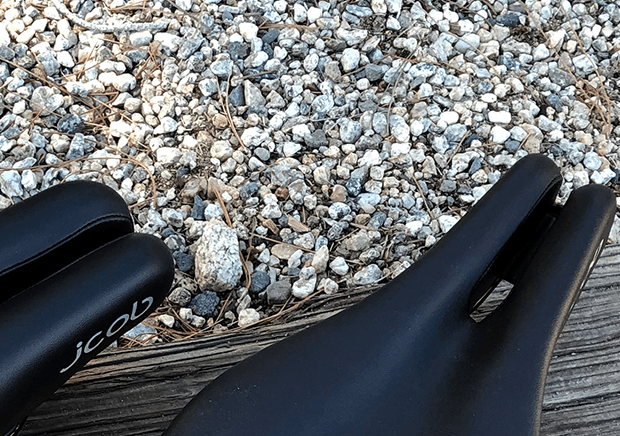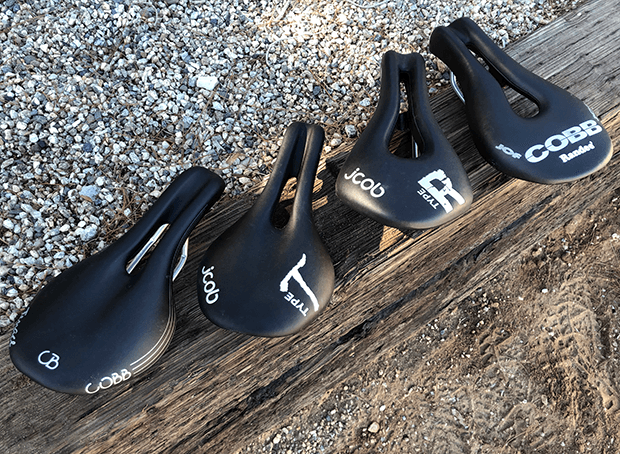The saddle landscape is changing underneath us. Not just the saddles but the brand names on them. (I'll speak to that below.) The styles of saddles - widths, shapes - everything's up for grabs and, for the purposes of what I'm writing below, I'm talking about what we’re riding on our no-draft tri (bikes with aerobars).
JCOB is an apt symbol for this; the brand that supports these saddle silhouettes has changed, and to some degree so have its saddle designs. There’s a discussion right now on our Reader Forum about this. That forum conversation revolves around the saddles you’d ride on your tri bike, specifically the “55” and the new “38” and I included an image of a 38 on a rather widely read photo gallery of a Cervelo P-Series last week.
The saddle some of you know as the 55 is now called the Type 5, and it appears to be the saddle that the first two men in the Hawaiian Ironman – Jan Frodeno and Tim O’Donnell – rode in the race. The 38 is similar, but narrower, and it is called the Delta 38. (These two saddles, the 55 and 38, are shown in the two images below.)

You’re all familiar with Cobb Cycling. The Cobb Mob. John Cobb, the man behind them. For years, that’s the brand with which you were familiar. The products I'm writing about today, and the company selling them, are now "saddled" with new nomenclature, and one goal today is to demystify all of this.
In my role as industry priest, analyst and TV doctor lots of people talk to me about the politics of business, so I pretty well have my arms around this brand and what surrounds it. Suffice it to say, because of ownership changes, intellectual property, contractual disputes, brand confusion, and the need to move forward, the brand of the saddle is now JCOB. Do you want the business particulars? Probably not. What I think I’ve learned from you all over the past 20 years is that your interest in saddles starts just below your waist and stops just above your thighs. Accordingly, at least for the purposes of this overview, this is all I’m going to write the business behind the brand.

There’s a couple of ways you can parse the designs that this company makes: traditional product versus new product; or you can divide this company's saddles up by use case.
Let me tell you how to know the difference between familiar product versus new product: If you go to the JCOB website (forget the domain name on that website; this brand is JCOB; period; and JCOB only), you’ll see the JCOB Signature Collection, and the Cobb Classic Collection.
For most of those saddles in the Classic Collection, this is your last bite at that apple. When those saddles are gone they're gone. As with run shoes, if you hate it when a company messes with your run shoe, here’s your chance to buy saddles you know and love before they’re gone.
The JCOB Signature Collection is new product but, apart from the Delta 38, most of it will look like something you’re familiar with. Those high-placing Ironmen mentioned above, maybe they each rode a 55 but if you order that saddle today it’s a JCOB Type 5.
The Delta M, Delta P, Delta V, are the current iterations of the V Flow Max, V Flow Plus, and V Flow respectively. (What was the V Flow family is shown just below; but they all have those new model names mentioned above.)

What’s the difference between "Delta", as in Delta 38, and "Type", as in Type 5? There’s also a Type T, Type R, Type 5. What does “Type” mean?
"Type" in this case means there’s a dedicated use case. It's a triathlon saddle, for example. Or Womens saddle. "Delta" means it spans more than one use case. It's an SUV: It’s unisex, or it’s for tri along with whatever else for which it may work.
If you look at the saddle silhouettes on the JCOB website, the Delta 38 and the Type 5 may look like they're completely different saddles, different shapes, curves, what have you. No. I have them both and they are quite similar. The main difference is in the width as it tapers from the flanges forward toward the nose. Why is one a "Delta" and the other a "Type"? If one is a Type 5, shouldn't the other by a Type 3.8? Or Something?
I'm going to try to answer this question in a moment, but this is a larger discussion and in the upcoming weeks I'll write on saddle trends among the top Kona riders, just as I’ve already written on wheel/tire and shoe/pedal trends. What I think I’m seeing is that, for some riders, saddle noses are getting narrower. I think this means some riders are sitting more square on the saddle. Riders aren't moving back, they’re moving their saddles forward, and sitting on rather than in front of their saddles. Once you adopt this posture, it makes a saddle a candidate for a use other than timed racing. Hence the 38 listed as a "Delta" rather than "Type".

There's another way of placing JCOB's saddles into categories, just based on what I see. The 55 was strictly a tri saddle, in my opinion, and as I wrote above, this was a saddle on which you sit in front of, like you’d ride an ISM. The weight, when you ride one of these saddles on a tri bike, is more (if you’re a man) on your ischial tuberosities than on your perineum (the pressure is off your taint and on your sit bones). Same idea for women, just, men and women have different soft tissue, but it’s all in roughly the same place - both men and women displaced their weight on their sit bones when riding on this kind of saddle. On saddles like this, your trunk never even touches the back half of the saddle. You can really only use these saddles in tri, in my opinion, because you're forced to rest a lot of your weight on the aerobars. You can't place all this weight on the front of a bike that doesn't have aerobars. Hence, a saddle like the 55, because of where you sit on it, is tri-only.
Then there are the JCOB saddles you sit atop, not in front of. I would have called this the V Flow family a year ago, but I'll soon need to change that because the V Flow model names appear to be going away. These are often saddles used in no-draft tri, but they’re not limited to this use case, because you can place most of your weight on them. Hence the "Delta" nomenclature attached to them. This is, according to my own way of categorizing JCOB's saddles, the second "family" of saddles in the JCOB line.
Then there are what you might call the comfort road saddles, the Randee and the Tenace, now called Type-R and Type-T (these are pictured above), and these are typically considered mens and women’s respectively, but I find as a bike fitter that these could easily have been labeled as Delta saddles. You just slap them under a rider – I don’t care the use case – and sometimes, voila, success!

Finally, you have JCOB’s non-traditional take on traditional road. Carbon Soft, Carbon Lite, Pro SR, Delta S. That last one, the Delta S (above), its precursors were Jordan Rapp’s favorite tri bike saddle for years. He wouldn’t ride anything else, until he got on a Dash. This and the Dash is where he spent the bulk of his tri career. Hence it getting the Delta prefix I guess (tri or road).
The other 3 of these saddles - what I'll call "performance road" saddles if you don't mine - I don’t have these; haven’t ridden them; but they are built on the same shell shape as the San Remo. These do not seem that different from the Sella Italia Flite, just with a lot of relief channels and pressure cut-outs. (I’m intrigued by these for road and gravel.) Here’s more on JCOB saddles.



